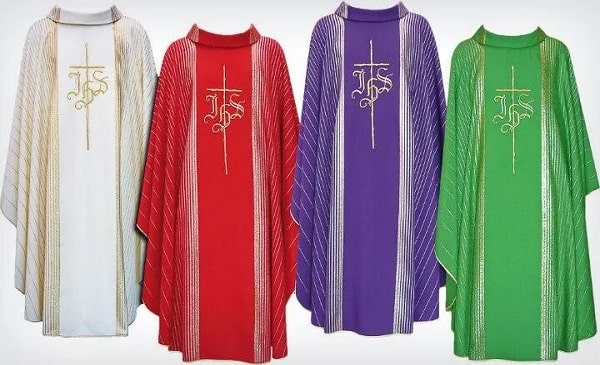Liturgical Colours: Meaning in Catholic Church
Colours are the most important symbols in the Mass, a tradition of the Catholic Church instructed by Christ in the Eucharistic sacrament, and reinforced by himself in the forty days progressive to the resurrection. To know more about the Catholic Liturgical Colours continue reading this article.
The variety of colours in the sacred dresses expresses in a physical and visual way the proper character of the mysteries of the faith that are celebrated, and the successive meaning of Christian life as the liturgical year passes; in other words, the liturgical colours show the experiences of the church or house of God.

If you want to learn what each colour used by God’s representatives on earth means, their intention and in what celebration each one is used, then continue reading this article.
Liturgical Colours
Liturgical colours, as mentioned above, have a meaning and are not always used for the same ceremonies.
Although we do not see the importance, the truth is that the different clothes used by God’s representatives on earth are important and know what each one is used for and what each colour also represents.
This diversity of colours in the sacred vestments seeks to express efficiently and in a visible, external way, each of the characters of each of the mysteries, festivals and celebrations throughout the year.
The liturgical year is the name given to the year of the Lord, in which various celebrations are held in honor of God the Almighty and eternal Father, his mysteries, and these, in turn, are represented by the different colours of the liturgical vestments.
What do the liturgical colors mean and when are they used?
Mainly, the liturgical colours express the experience of an entire people and of the Church of God on earth, that is, every time we observe that the priest uses a new colour in his garment, he is giving us a message.
What is that message that the priest offers us? That we are in the celebration of some mystery of the life, work, death or resurrection of the Son of God.
White Colour
The White Colour, not only in the Church but in life in general, represents purity, cleanliness, purification, innocence, divine grace, light, and even joy, these last three, from a more religious sense.
These Liturgical Colours are used by the priest to communicate without the need for words that we are celebrating the nativity or the resurrection of Jesus, for example.
The white colour is also used in Easter time, festivals in honour of our Lord God the Father or in any celebration of the Virgin Mary, Mother of God.
It is also used to represent saints, angels, and non-martyrs because it is the colour that represents Easter joy, life, and light, the ascension.
Red
The Red Colour, not only in the Church but in life in general, represents blood, heat, fire, and love (as a couple, brothers, family, friends, among others) and in a more religious sense, it also represents sacrifice, love of God and heroism.
The colour red is used mainly in the Pentecost festival, although it is also used on Good Friday and Palm Sunday.
Liturgical Colours, in this case, the colour red, is used in all the festivals that represent the Passion of Christ the Redeemer and in the festivals of all those martyrs who gave their lives with the greatest joy and happiness because they held firm their faith and their love and devotion to God.
Green
One of the Liturgical Colours that we see priests use is commonly green since this colour is used during the week when there is no special festival to celebrate in the liturgical year.
The green colour represents hope, freshness, well-being, health, and in a more religious sense, it represents the freshness and freshness of our soul, the beautiful virtue of hope and the good fruit that God offers us and also expects from us.
This liturgical colour is used during ordinary time, that is, the period that includes from the baptism of Jesus to Lent, passing through Pentecost and finally reaching Advent.
Purple
The colour purple generally represents nobility, luxury, magic, spirituality, royalty, even creativity. From a more religious sense, the priest every time he uses the colour purple is telling us or representing piety.
Purple is one of the Liturgical Colours also quite recognized by the Christian community since it is used in the Lenten season and in votive Masses, i.e. those Masses that are celebrated with a special intention.
Some of these special intentions could be: requesting God’s intervention for some problem that we cannot find a solution to, some anguish or any other request that requires divine intervention from our beloved Father.
The purple colour is also used for the celebrations of the masses of a deceased person, representing then, in these cases: penance, waiting, humility and a call to conversion permanently.
Less used colors
Although there are many Liturgical Colours, there are also liturgical colours that are not as widely used, or at least not as common as red, green, purple or white.
Something that is very striking is that these Liturgical Colours are seven (7) and the number seven has a special meaning for the Catholic Church.
For example, the number seven (7) represents a message or an idea that is beyond our understanding and human comprehension. It can represent hidden messages, so to speak that it is sent by God so that we understand or solve a situation in the best way, by placing a case.
The number seven (7) also represents perfection for the Catholic Church, therefore, in the Holy Bible, we can find that Peter had to forgive his brother even seventy (70) times.
Gold or Silver
Now, going back to the subject, we go with the gold colour or the silver colour. The golden colour, as is evident, represents gold, money and even happiness. Abundance, prosperity and material things.
The golden colour within the Liturgical Colours represents a more traditional and even a little gloomy aura.
When a priest uses the colour gold, he is highlighting his priesthood, the importance that it has as a disciple of God and as his representative on earth to guide his children, just as a shepherd does with his sheep.
The golden colour, also, stands out and represents great parties. On days that are considered solemn, this colour is often used to highlight the noblest ornaments, although these ornaments do not correspond to the colour of the day.
In the case of silver, this usually represents luxury, the value of the material goods that we can acquire, the ideal value, although it always goes after gold since this is the main colour.
In a more biblical or religious sense, this silver colour represents solemnity.
Pink
When we think of the colour pink, it is normal to think of a woman, strength, beauty, fullness, balance, but from a more biblical or religious sense, when the father or priest uses the colour pink, it is with the intention of showing us that the closeness of the Savior is very close.
Normally, this pink colour is used by the priest on the third Sunday of Advent, and it symbolizes within the Catholic Church also a symbol of ephemeral joy, rather, it is rigour.
When we speak of this ephemeral joy it is because it is used on the fourth Sunday in the season of Lent, at this time, as we know, it is a time when Easter is celebrated, that is, the triumphant entry of Christ into the promised land.
The colour pink is relaxing, it is inevitable that it influences our feelings and inspires us to act in a kind, delicate way, to converse with others in a deep way, or to reflect on ourselves and our feelings in a sincere and transparent way.
Colour pink is something like love but more subdued, it is affection, it is sweetness, it is even protection. It is also a sign of our innocence, of our generosity through our actions and dedication to God and our loved ones: family, friends, among others.
Blue
And we have reached the end of these liturgical colours, we reached the colour blue, that colour that is so wonderful for many and that represents peace, tranquility, relaxation, that wonderful feeling that the sea and its immensity offer us.
The colour blue can be absolute calm, as well as represent storm and movement, madness.
The colour blue in a more religious sense is used to represent or honor the beloved Virgin Mary, mother of God and mother of all men and creatures on earth.
Our beloved Mother, divine mother, that mother, who with her love, her mercy and her sacred mantle always offers us her protection, her shelter and the understanding that mothers cannot lack.
A mother is always willing to receive us with open arms, to forgive and love us unconditionally regardless of our mistakes or sins, and for this and much more, we must honor, love, and reciprocate in the same way.

![50 Trendy Velvet Suit Jacket Designs ([year]) velvet suit jackets](https://eucarlwears.com/wp-content/uploads/2023/07/1689690637627-768x960.webp)




![How To Style Ankara Hats ([year]) & Recent Designs Ankara Hats](https://eucarlwears.com/wp-content/uploads/2022/10/Brown-Simple-Family-Time-Photo-Collage-6-768x614.webp)